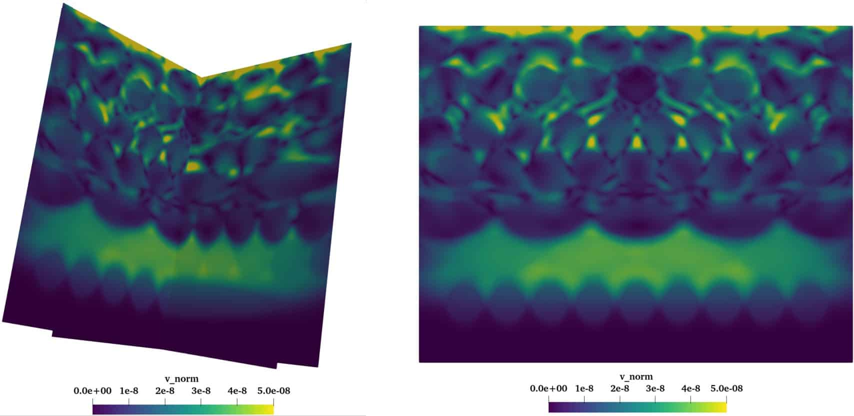Исследователи МФТИ провели анализ распространения ультразвуковых волн в композитных материалах.
The work has been published in the Lobachevskii Journal of Mathematics. In recent years, composite materials have gained recognition in various industries, including aviation and construction, due to their exceptional properties. However, ensuring their structural integrity and quality control presents complex challenges.
The study conducted by researchers from the MIPT aims to enhance the understanding of the dynamics of ultrasound wave distribution in such materials by utilizing innovative modeling techniques that promise to revolutionize the approach to non-destructive testing.
The paper introduces a new generation of methods based on chimera grids and the grid-characteristic method, which together create a powerful tool for describing wave dynamics in isotropic linear elastic media. This research allows for a deeper understanding of the mechanisms of ultrasound wave propagation, opening new avenues for the analysis and diagnostics of composite structures. Researchers selected an isotropic linear elastic medium as the primary model to better understand the influence of internal structure on wave processes. The grid-characteristic method, applied simultaneously on structured and curvilinear grids, enables precise descriptions of wave interactions at material interfaces.
A distinctive feature of the method employed by the scientists is the integration of chimera grids into a single background grid. In this case, the background grid has discontinuities in elastic parameters at the interfaces between different materials. Chimera grids positioned on both sides of these discontinuities serve to represent individual structures with a high level of detail within their boundaries. Elastic parameters at the nodes of the overlaying chimera grids are set according to the baseline parameters of the background nodes. This approach allows for independent solution finding in each computational grid for the subsequent time step.
The solution process unfolds independently on each grid, providing results for the next time step. Subsequently, the variable values at the nodes of the background grid are refined through interpolation from the overlaying chimera grids. This approach eliminates the need for more complex methods to account for discontinuities in the background grid, optimizing the computational process.
A crucial consideration in this holistic approach to modeling ultrasound propagation is seamless parallelization of computations. The background grid is spatially partitioned into separate areas where calculations are performed in parallel. In the chimera grids, computations for individual inhomogeneities are carried out independently of other structures. This autonomy allows each core to efficiently manage the required number of structural grids.
The method has been applied to investigate the propagation of ultrasound waves in a composite material consisting of eight layers of cylindrical fibers arranged at different angles and embedded in epoxy resin. The cylindrical fibers have a radius of 0.1 mm. The physical dimensions of the modeling area are 1 cm x 1 cm x 2 mm. The computational grid supports a step size of 0.001 mm, and although the curvilinear grids introduce distortions, the step change does not exceed 1.5 times that of the background grid. The adopted temporal resolution was a time step of one nanosecond, and the total simulated time was one microsecond.
The method accounts for more complex fiber shapes beyond the simplified cylindrical form. The adhesion boundary condition is defined at the interface of the external and internal chimera grids, determining the boundary of the fiber. Non-reflection conditions were set at the boundaries of the computational domain.
The modeled ultrasound source took the form of a pulse corresponding to a fourth-degree sine wave with a frequency of 20 MHz. In modeling the materials, a continuous elastic medium model was used, with parameters derived from the properties of real materials: longitudinal sound wave speed, transverse sound wave speed, and material density.
The simulation results demonstrated the dynamics of wave propagation within the composite material. A comparative analysis showed that the new method outperformed the traditional approach based on variable elastic parameters by providing a more nuanced consideration of the material’s microstructure and yielding more reliable results.

“Traditional modeling methods are often developed based on anisotropic models that do not always accurately capture the nuances of the microstructures of composite materials,” explained Evgeny Pesnya, a staff member of the Department of Computational Physics at MIPT. “The developed approach overcomes these limitations, providing researchers with tools for an in-depth analysis of ultrasonic wave interactions, ensuring a detailed understanding of wavefront behavior, especially at material boundaries.”
“The grid-characteristic method, which forms the basis of this research, allows for a more precise description of wave processes, eliminating issues associated with classical finite element methods. As a result, the new modeling technologies emphasize microstructural features and their impact on ultrasound propagation. This further underscores the importance of adapting approaches to modern requirements and standards of non-destructive testing,” added Igor Petrov, a corresponding member of the Russian Academy of Sciences and professor at the MIPT Department of Computational Physics.
This research, based on a combination of advanced methodologies, promises to make a significant contribution to non-destructive testing and monitoring of aviation structures, as previously used approximate anisotropic models fail to account for all types of waves in composite materials according to studies by foreign colleagues. The developed methodology enhances the understanding of complex interactions and dynamic phenomena occurring in composite materials. With each new step forward, scientists are getting closer to more accurate and effective monitoring of structural conditions. The further development of modeling methods will serve the cause of safety and reliability in the most challenging engineering tasks.
The research is supported by a grant from the Russian Science Foundation.